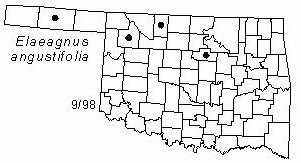Small tree to 8 m (25 ft) tall and 20 cm (8 in) in diameter, usually with a short crooked trunk. Bark gray-brown, peeling in long strips, becoming blackish and deeply furrowed on old trunks. Twigs long, thin, covered with very small silvery scales when young, becoming reddish-brown, often spiny or ending in a spine. Buds small, rounded. Leaves alternate, lanceolate or oblong, 3-6 cm (1.2-2.4 in) long and 1-2 cm (0.4-0.8 in) wide, dull gray-green above, covered with small silvery scales and brown dots below. Flowers in clusters of 1-3 scattered along twigs at leaf bases, about 1 cm (0.4 in) long, apetalous, sepals yellowish inside and silvery outside, blooming in late Spring. Fruits olive-shaped, about 1 cm (0.4 in) long, yellow to brown, covered with silvery scales, maturing in late Summer.
Distribution: Native to eastern Europe and central Asia, but widely planted and escaping in North America.
Habitat: In Oklahoma, mostly roadsides and abandoned fields. Persistent in old shelterbelts and old homesites.
NWI status: FAC
Comment: Russian olive is widely used as an ornamental, and was often planted in shelterbelts and windbreaks on the Great Plains. A related species, Autumn olive (E. umbellata), is sometimes planted and may escape. Autumn olive is usually a shrub and has red fruits. Elaeagnus is derived from two Greek words meaning "olive" and "lamb" (?!); angustifolia refers to the narrow leaves.
Distribution in Oklahoma: 
BACK
NEXT
RETURN TO INDEX
Last update: 9/10/99
 Go to Oklahoma Biological Survey Home Page
Go to Oklahoma Biological Survey Home Page
 Disclaimer
Disclaimer